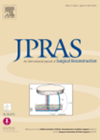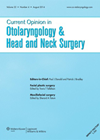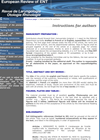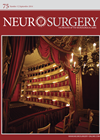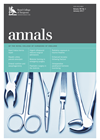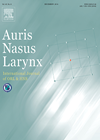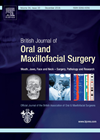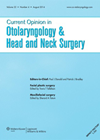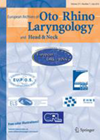
Journal Reviews
Multiple free flaps for head and neck cancer
Most patients with advanced head and neck cancers now undergo microvascular free flap reconstruction. This is mainly as flaps facilitate complete tumour and margin removal by providing reliable wound coverage and better restoration of form and function. However despite this,...
Anterior skull-base surgery: current opinion
This review examines the changes in the field of anterior skull-base surgery and the rapid advancement that has taken place in the last 10–15 years. Tumours of the anterior skull base that were once considered inoperable are now routinely resected...
Day care or admission for aesthetic nasal surgery?
Day-care surgery is gaining in popularity throughout the surgical specialities due to economical constraints and patient convenience. However this is not without risk and a careful procedure by procedure evaluation should be performed to prove the suitability of this type...
Patients with advanced oral cavity carcinoma are not candidates for the ‘organ preservation’ approach
The authors of this study, from the University of Michigan, evaluated the role of induction chemotherapy for patients with stages III and IV resectable oral squamous cell carcinoma. Nineteen patients were initially enrolled in the induction chemotherapy cohort. Patients with...
Stereotactic radiosurgery for pituitary adenomas
Residual and recurrent functioning pituitary adenomas can be difficult to delineate on postoperative MRI scans, making them difficult targets for stereotactic radio surgery. In such cases radiation delivery to the entire sellar has been utilised as a radio surgical equivalent...
Primary ossicular chain reconstruction in open-cavity mastoidectomy
The authors performed a retrospective analysis of 21 patients who had undergone primary reconstruction of the ossicular chain during canal-wall-down mastoidectomy. The ossiculoplasty technique used consisted of removal of the malleus head and division of tensor tympani, and rotation of...
A new septoplasty technique
This article describes a novel septoplasty technique to correct a cartilaginous deflection. Although it took a while to understand it as the operative photographs were not very helpful it is an interesting concept. The author excises an inferior strip and...
Risk factors for post tonsillectomy bleeds
This paper reviews post-tonsillectomy bleeding in 692 patients and attempts to tease out risk factors. The overall bleed rate of 11.6% seems very high. The return to theatre rate was 2.6%. The paper identifies male patients and adult patients as...
Is it time for cone-beam CTs to replace the traditional orthopantomogram in the primary diagnosis of temporomandibular joint disorders?
Cone-beam CT requires a lower dose of radiation compared to the multidetector CT and provides much more detailed information in 3D about the bony structures of the temporomandibular joint (TMJ) when compared to the traditional orthopantomogram (OPG). In this article...
Fungal rhinosinusitis
Allergic fungal rhinosinusitis (AFRS) has been defined by the following characteristics: presence of nasal discharge, nasal obstruction, decreased sense of smell or facial pressure for 12 weeks, mucin within the sinus cavity containing fungal hyphae and degranulating eosinophils, endoscopic evidence...
Tracheostomy safety project
Tracheostomy care is evolving, with the majority of procedures now performed percutaneously to facilitate weaning from mechanical ventilation in the critically ill. Traditional surgical indications remain, but surgical tracheostomies are increasingly performed in more complex patients. This brings unique challenges...
The anatomy and actual number of branches of the sphenopalatine artery: surgical implications
Endoscopic sphenopalatine artery ligation or cauterisation is nowadays the main treatment for epistaxis unresponsive to medical therapy. However, on review of the literature, there appears to be confusion relating to the anatomical nomenclature of the sphenopalatine artery branches and more...

